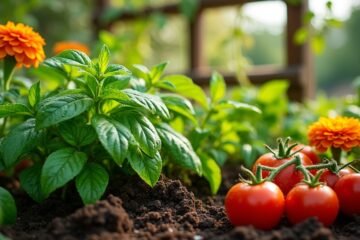Get ready to spruce up your vegetable garden in 2025 with some fabulous companion plants! Imagine vibrant basil dancing beside your juicy tomatoes, boosting flavor and keeping pesky insects away. Picture marigolds luring in pollinators while warding off unwanted aphids from your cucumbers. And don’t forget those nutrient-rich buddies like borage for your leafy greens! Excited to transform your garden into a thriving ecosystem? Stick around—there’s so much more to discover about the perfect plant pairings!
Understanding Companion Planting Principles
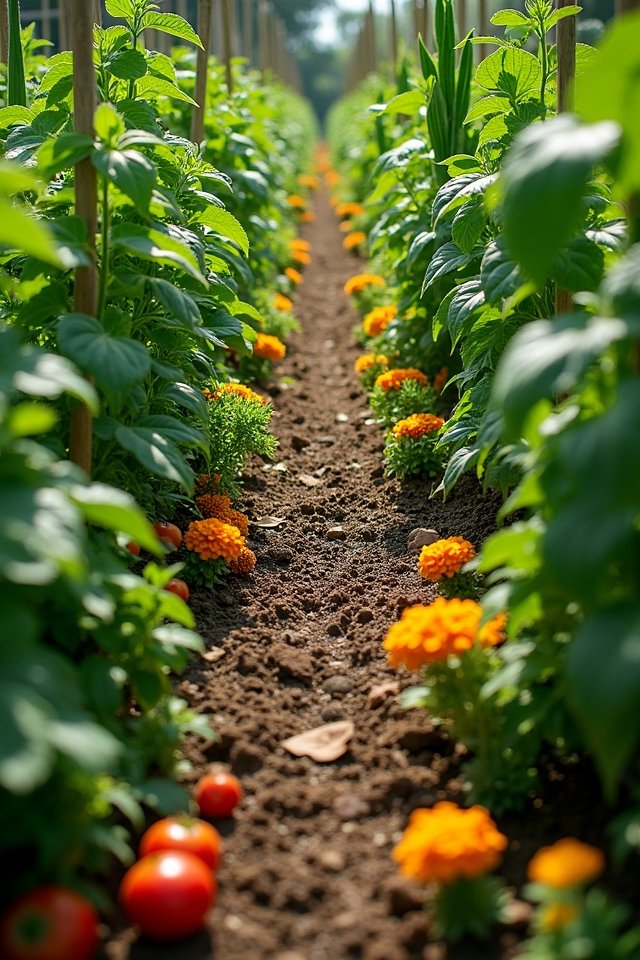
When you immerse yourself in the world of companion planting, it’s like discovering a secret recipe for a thriving vegetable garden! You’ll quickly realize that plant synergy isn’t just a buzzword; it’s the magic that happens when you pair certain plants together. For instance, planting basil alongside tomatoes can enhance flavor while also repelling pesky pests—talk about a win-win! Your soil health goes through the roof too, as these companion plants work harmoniously to create nutrient-rich environments. Plus, the vibrant colors and aromas will delight your senses! Isn’t it exciting to think about how a handful of well-chosen companions can elevate your garden from ordinary to extraordinary? Let’s cultivate some green-thumb creativity and watch those veggies flourish!
Top Companion Plants for Tomatoes
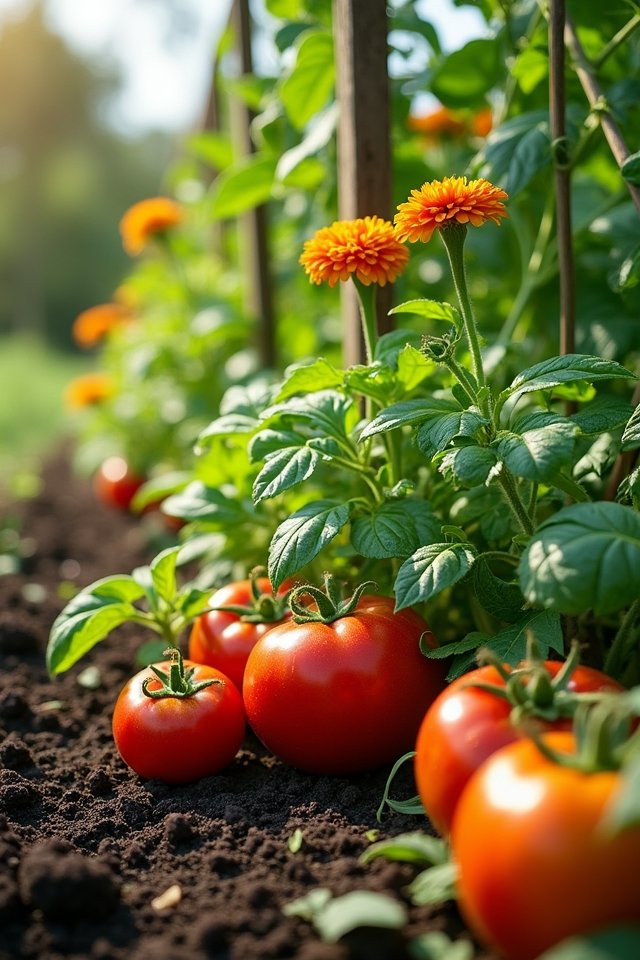
Tomatoes are like the stars of your vegetable garden, demanding attention with their luscious, juicy fruits. To help them shine, you’ll want some stellar companions that boost their growth and tackle pests. Here are three must-have plants:
- Basil: This fragrant herb not only enhances flavor but also wards off pesky insects.
- Marigolds: Their bright blooms attract pollinators and keep aphids at bay!
- Garlic: Planting this beneath your tomatoes can combat nematodes and improve pest management.
When experimenting with different tomato varieties, you’ll find that pairing them with these delightful companions creates a flourishing garden that’s vibrant and productive! Can you imagine the scents and colors mingling together? It’s a match made in gardening heaven!
Best Partners for Cucumbers
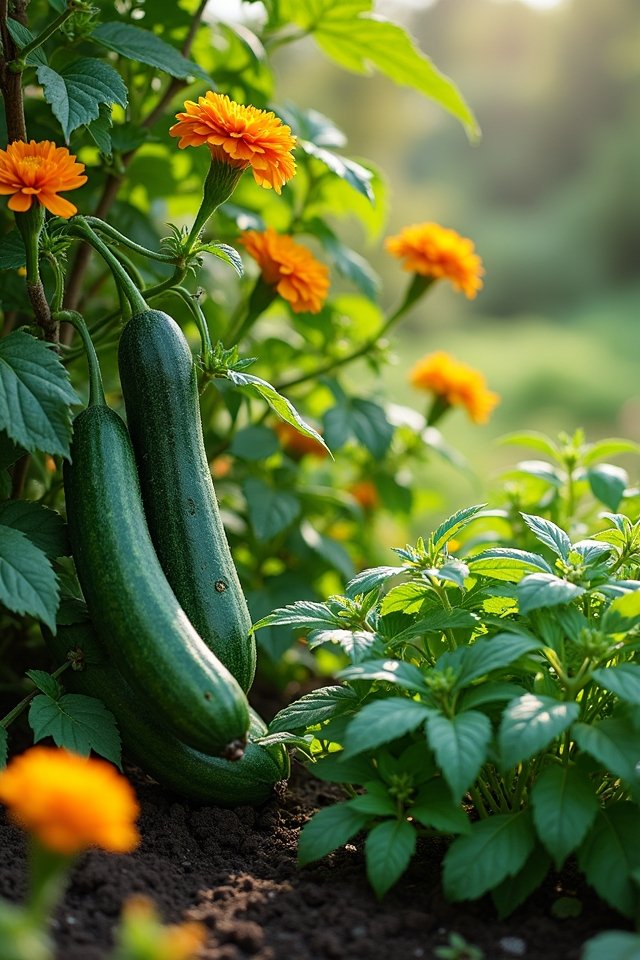
Cucumbers are an invigorating delight in any garden, especially when you pair them with some fabulous friends! To boost your cucumber companions, consider planting marigolds. Their bright blossoms not only attract beneficial insects, but they also help fend off pesky pests. Nasturtiums are another great choice; they act as a living trap for aphids, keeping those little devils far from your cucumbers! Plus, their peppery leaves are a tasty addition to salads. You’ll appreciate how these vibrant plants enhance disease resistance, creating a harmonious environment. And let’s not forget about beans—these natural climbers can maximize space while enriching the soil! So, mix it up and watch your garden flourish with these wonderful cucumber buddies! Isn’t gardening such a thrill?
Ideal Companions for Peppers
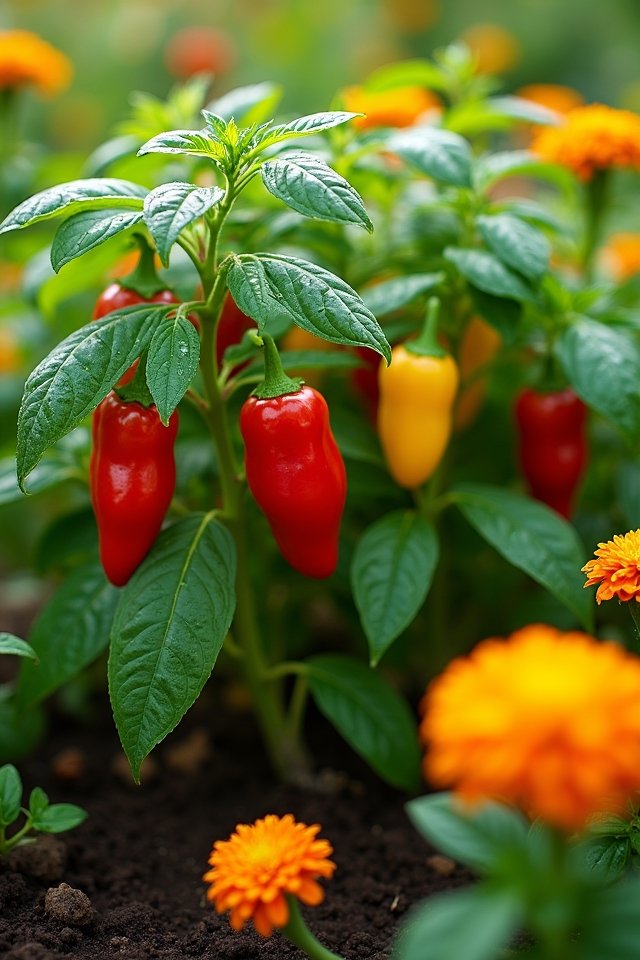
While you’re planning your splendid pepper patch, consider inviting some charming companions to join the show! These delightful plants can enhance your garden’s beauty and boost the health of your pepper varieties. Imagine seeking companions that can ward off pests and improve flavor—sounds amazing, right?
Here are a few ideal companions for peppers:
- Basil: This fragrant herb doesn’t just add zest to your dishes; it can repel pesky insects too!
- Marigolds: These bright beauties not only make your garden pop but also deter nematodes and pests.
- Onions: With their strong flavors, they’re great at keeping unwanted critters at bay while complementing your peppers in the kitchen.
Enhancing Growth With Basil and Other Herbs
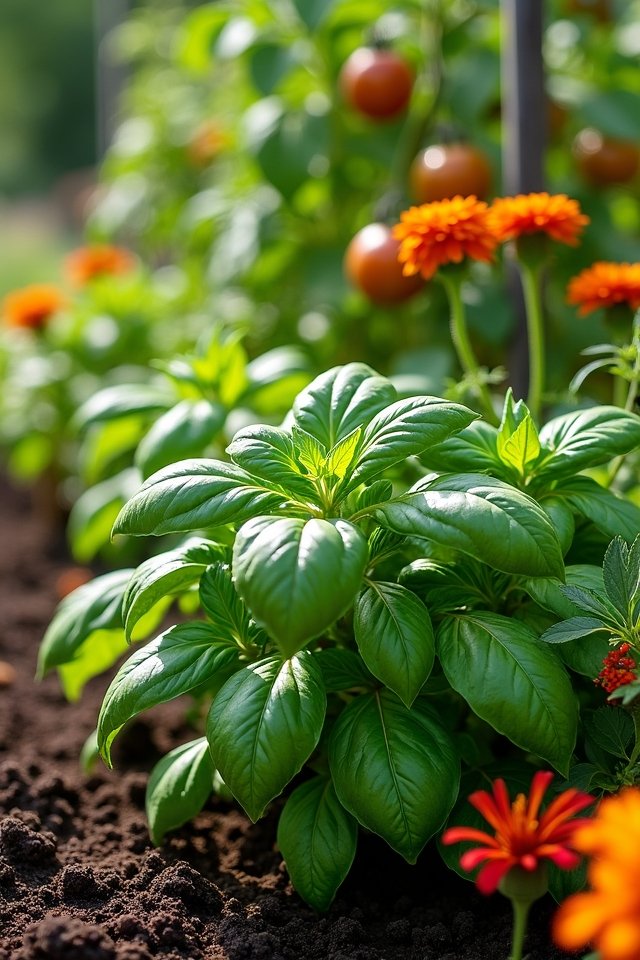
If you’re enthusiastic to see your pepper plants thrive, consider adding some aromatic herbs like basil to the mix! Basil benefits your garden not just with its delightful fragrance, but also its remarkable herb synergy. Planting basil close to your peppers can boost their growth, turning your veggie patch into a thriving oasis! The strong scent of basil repels pesky pests, while attracting lovely pollinators that can help those peppers reach their full potential. Imagine vibrant, juicy peppers complemented by a sprinkle of fresh basil—delicious! Plus, basil’s energy can enhance the flavors of your other herbs. Why not welcome this aromatic powerhouse? By incorporating basil, you’re not just gardening; you’re creating a culinary masterpiece!
Companion Plant Strategies for Carrots
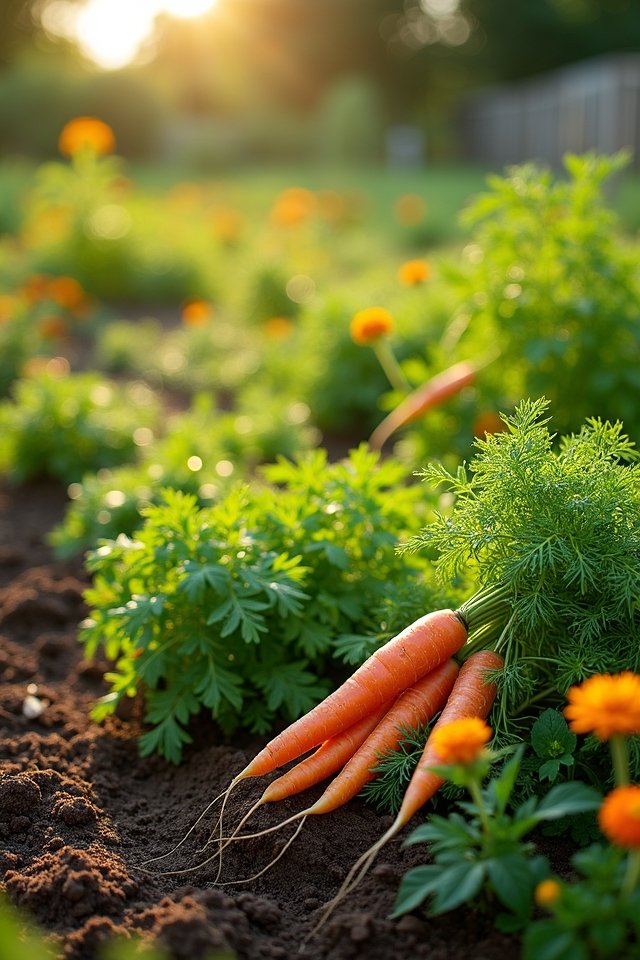
When you plant carrots, you’re not just sowing seeds; you’re creating a vibrant community in your garden! Your carrots (or carrot friends) thrive when they’ve got good company, and the right alliances can boost soil health, too. Think of your garden as a culinary team!
- Radishes: They’re great at breaking up soil and can help deter pesky pests.
- Onions: With their strong smell, they act like bodyguards for your carrots.
- Marigolds: These beauties not only spark joy but also keep harmful nematodes at bay.
Mixing these companions fosters a lively ecosystem, making your garden a haven for growth! Isn’t that a recipe for green thumbs and juicy carrots? 🌱
Protecting Plants: Pest-Repellent Companions
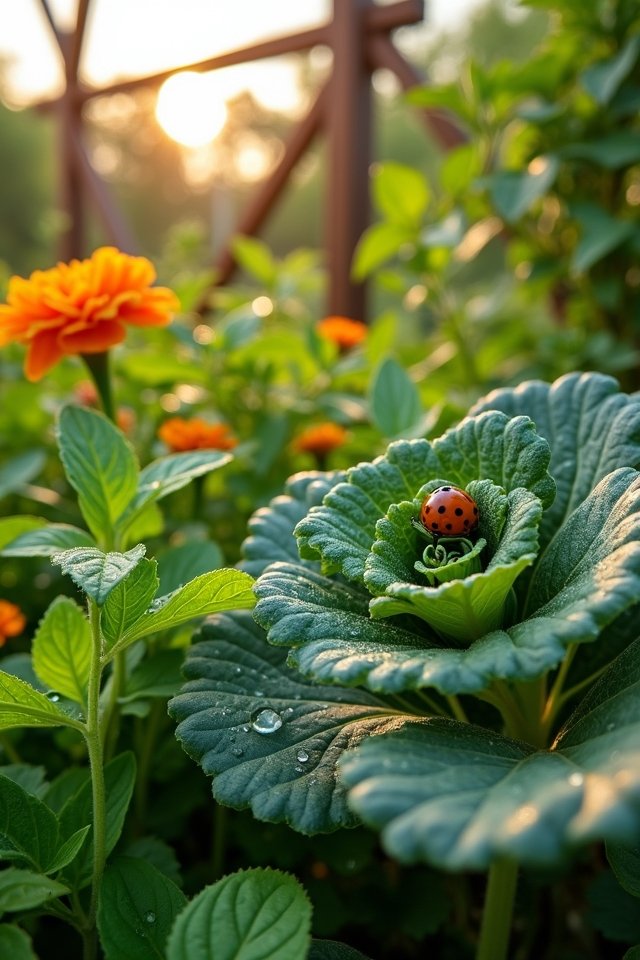
In a garden buzzing with life, the right pest-repellent companions can be your plants’ best friends! Think of marigolds as your garden’s little bodyguards, acting as nature’s pesticide. Their vibrant blooms release scents that drive away pesky aphids and nematodes—talk about a floral fortress! Basil is another superstar; its aromatic leaves work like a shield against flies and mosquitoes. Plus, it enhances tomatoes’ flavor—win-win! Imagine planting garlic nearby—its pungent aroma adds another layer of protection while making you the envy of culinary circles! By choosing these natural repellents, you’re not just protecting your plants; you’re crafting a thriving ecosystem. Ready to make your garden a safe haven? Welcome innovative companions and watch the magic unfold!
Nutrient Boosters for Leafy Greens
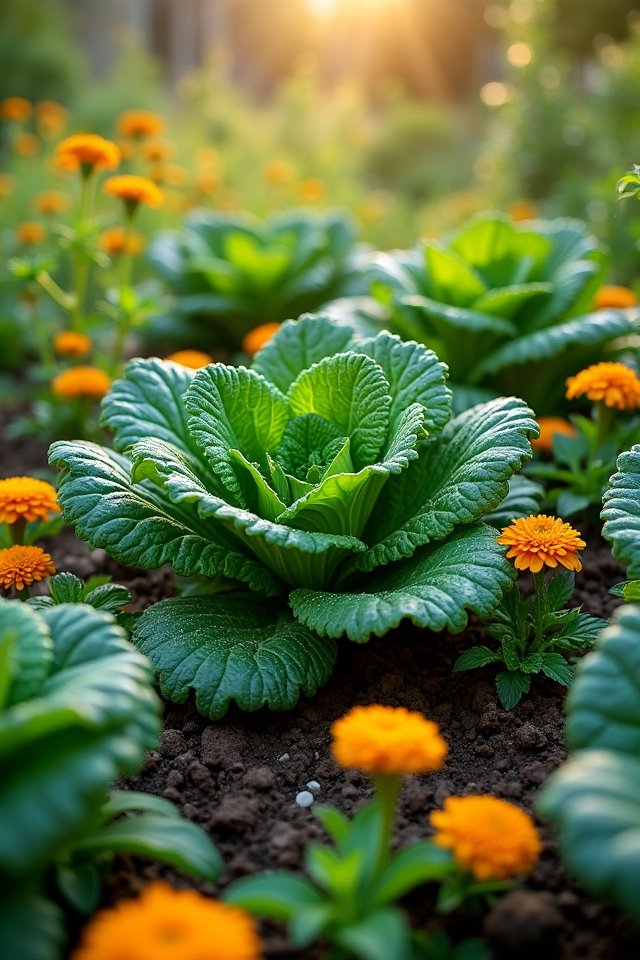
To truly nourish your leafy greens, consider adding a few nutrient-boosting companions to your garden! These fabulous friends not only enhance leafy green nutrients but also work wonders in maximizing companion plant benefits. Why not give these plant pals a go?
- Nasturtiums: They attract pollinators and deter aphids, making your greens happier and healthier!
- Borage: This cool cucumber of a plant skyrockets nutrient levels, especially calcium, while attracting helpful bees.
- Crimson Clover: A champion in fixing nitrogen in the soil, it enriches the ground beneath your greens, promoting lush growth!
Frequently Asked Questions
Can Companion Plants Improve Soil Quality in My Garden?
Think of companion plants as dynamic duo superheroes in your garden. They boost soil nutrients and ramp up microbial activity, transforming your plot into a rich paradise. For example, planting clover with veggies replenishes nitrogen, like a protein shake for your soil! It’s a win-win—your plants thrive, and you enjoy a bumper crop. So, why not give those companions a shot? Your garden’s health will dance with joy, and you’ll be grinning!
How Do I Choose Companion Plants for My Local Climate?
To choose companion plants for your local climate, check your plant hardiness zone! This helps you select regional vegetables that thrive together. For instance, if you’re in a warmer zone, think about pairing zesty peppers with fragrant basil; they’ll both flourish! Don’t forget—look for plants that naturally boost each other’s growth, like carrots and onions. It’s like throwing a fantastic garden party! Your plants can be the best of buddies, making your harvest bountiful and delightful!
Are There Any Companion Plants to Avoid?
Not every plant’s a friend in the garden! You’ll want to dodge companions like fennel and coriander, since they can stunt your veggies’ growth. They’re like party-crashers at your green soirée! Also, consider avoiding plants that have toxicity—like certain nightshades—as they can create negative plant interactions. Imagine your beautiful garden thriving with friends instead of foes! Choose wisely, and your plants will sing a happy tune!
How Close Should Companion Plants Be Planted Together?
When you’re arranging your companion plants, think of plant spacing like a cozy dinner party! Ideally, you want them about 12 to 24 inches apart. This gives them room to grow and mingle without stepping on each other’s roots. Just like finding the right seat, the right arrangement can foster harmony. For example, plant basil near tomatoes—they’ll thrive together! Remember, happy plants make for a spectacular garden feast! Isn’t that a delightful thought?
Can Companion Planting Be Practiced in Container Gardens?
Absolutely, you can practice companion planting in container gardens! Think of your containers as cozy garden apartments, welcoming diverse plants to thrive together. Using companion planting techniques, like pairing basil with tomatoes, can boost flavors and deter pests! The benefits of container gardening—like control over soil and moisture—make this a brilliant option. Have you ever tasted a fresh basil-tomato salad from your own patio? It’s culinary joy at your fingertips! Now, let’s get planting!


